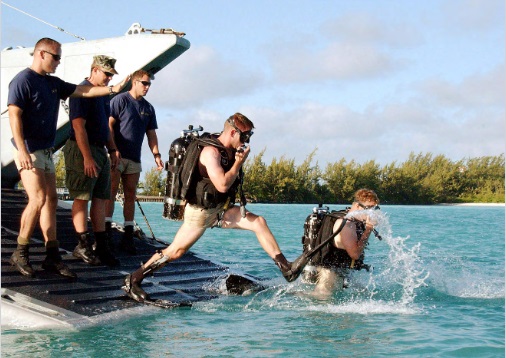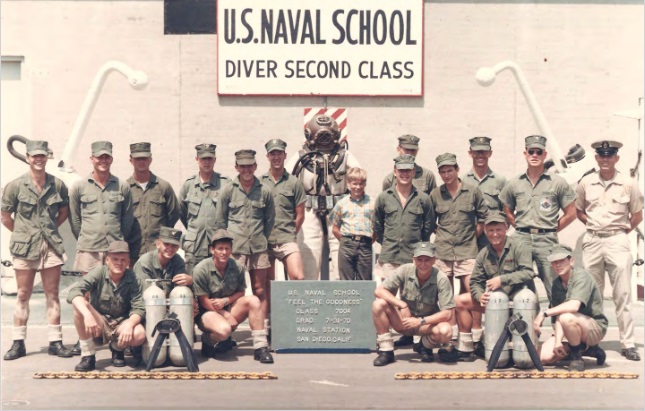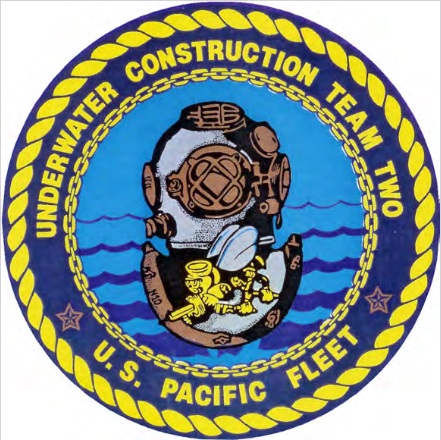The History of Underwater Construction Team (UCT) TWO
Underwater Construction Team (UCT) TWO Command History
The Underwater Construction Team (UCT) TWO was established as an independent unit of the Naval Construction Force (NCF), US Pacific Fleet in 1973. It is one of two UCTs in the Navy. Its sister unit, UCT ONE, is out of Little Creek, Virginia. The Team’s mission is to provide a responsive military capability for underwater and waterfront engineering, construction and repair in support of Navy and Marine Corps operations. To perform this mission, UCT TWO has 69 enlisted personnel and three officers assigned to the unit. Seabee construction diving began in World War II in conjunction with the building of numerous advance bases in the Pacific. Operations consisted primarily of underwater blasting of coral reefs, and the inshore work to provide channels and mooring facilities for shipping. Divers assigned to Naval Mobile Construction Battalions did most of the diving; however, some small diving units were formed to perform underwater construction, demolition, and salvage projects. Among these units were the Underwater Demolition Teams (UDTs), which were comprised in part of Seabee divers. In the mid 1960’s, renewed interest in ocean engineering and underwater construction revived the need for specially trained and experienced construction divers. Seabee divers became major contributors to the early success of the "Man-in-the-Sea" programs, including SEALAB II and TEKTITE II undersea laboratories. As a result, the CNO in 1970 authorized the formation of specially trained Seabee detachments for the purpose of construction and repair of underwater facilities. As the need for Seabee divers increased, the UCTs were designated as independent units in 1974. The title of Officer in Charge was changed to Commanding Officer in 1985. Since its establishment, UCT TWO has deployed to every naval installation in the Pacific, as well as several sites in the Atlantic, the Arctic, and the Antarctic. The Team currently deploys three 15-member air detachments on a 6/12-month deployment/homeport cycle. One deploys for six months, while one is in a six-month maintenance cycle, and the third is in a six-month training cycle to prepare for its upcoming deployment. UCT TWO is the only Naval Construction Force unit to utilize this deployment cycle to maintain year-round availability. Over the last few years, UCT TWO has deployed Air Detachments to Iraq in support of OPERATION IRAQI FREEDOM I and to Sangley Point and Zamboanga Philippines to provide mission critical waterfront facilities to Joint Special Operations Task Forces (JSOTF) in support of OPERATION ENDURING FREEDOM. The Command deployed another Air Detachment in support of OPERATION UNIFIED ASSISTANCE providing humanitarian relief from a devastating Tsunami that hit Southeast Asia in December 2004. UCT TWO has invested many hours in tactical weapons and demolitions training while being deployed to the jungles of Thailand, the Islands of the Philippines and up and down the Pacific coastline of the United States. The Command has also completed many highly challenging underwater construction projects to support the Fleet in various locations throughout the Pacific Area of Responsibility, including Kauai and Pearl Harbor Hawaii, Diego Garcia, Whidbey Island, Guam, Sasebo and Yokosuka Japan, San Clemente Island and San Diego CA.
Source: Naval History & Heritage *Comand*



LATEST ARTICLES
- “El Buzo,” or “The Diver,”... Statue... Mexico.
- Dive Into History
- Depth Of The Deepest Dive With Breathing Apparatus
- A BRIEF HISTORY OF DIVING: FREE DIVERS, BELLS AND HELMETS
- Saturation Diving Technique
- 20,000 lies under the sea ... The fishy world of Jacques Cousteau
- Royal de Luxe ... The Giant Diver Mechanical Marionette
- Europe's first underwater museum opens off Lanzarote
- Cousteau legacy still making a splash
- In Memoriam | Bob Kirby: 1933-2022
- The COMEX Story
- 10 Things No One Tells You Before You Become A Deep Sea Diver
- Diving Suits through History
- Training And Qualifications in Commercial Diving
- Australia’s deepest ever commercial dive leads to brain injuries, mental scarring


